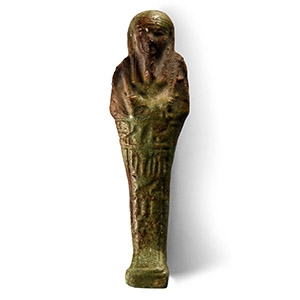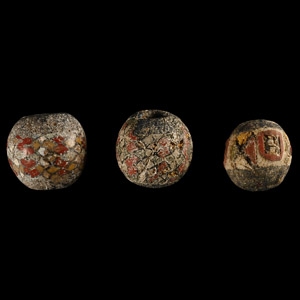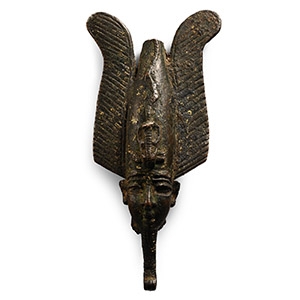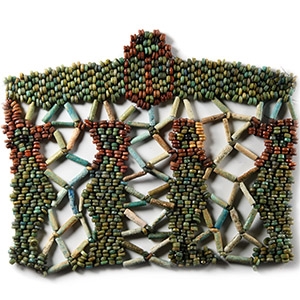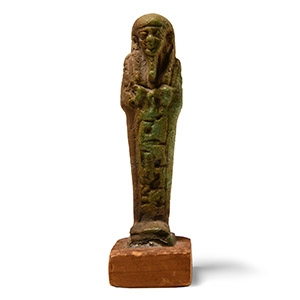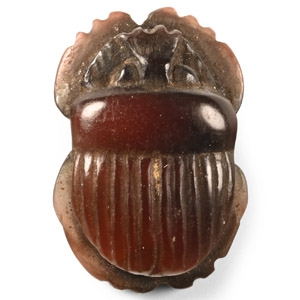Home > Auctions > 4 June - 8 June 2024
Ancient Art, Antiquities, Natural History & Coins
Auction Highlights:
Acquired from Hotel des Ventes, Drouot, in the early 1980s.
Ex collection of a private collector.
Property of a French collector.
Cf. von Droste zu Hülsdorf, V. and Schlick-Nolte, B., Ägyptische Bildwerke II: Statuetten, Gefässe und Geräte, Melsungen, 1990, pp.161-162, no. 78, for the shabti type.
Collected from 1969-1999.
From the collection of the late Mr S.M., London, UK.
Acquired on the German art market, 1989-1995.
with The Museum Gallery, 19 Bury Place, London, WC1, UK, 1998-2003.
Property of a London based academic, 2003-present.
Cf. Daressy, G., Catalogue général des antiquités égyptiennes du Musée du Caire N° 38001-39384 Statues de divinités, Cairo, 1906, pl. XVI, no. 38.261, for complete statuette with comparable head.
Osiris is a deity who represents death and fertility and is commonly regarded as the quintessential god of rebirth. Though he was once a mortal ruler, as a deceased entity, his domain was the Underworld. Abydos was the primary centre of Osiris’ cult, where a renowned yearly celebration of the god was held. This head comes from a once sizeable statuette of the god.
From the H.N. collection, Milton Keynes, Berkshire, UK, 1990s.
Cf. Andrews, C., Amulets of Ancient Egypt, London, 1994, pp.62-3.
Fly amulets were believed to protect against insect bites and ward off flying creatures through apotropaic magic. Additionally, the pharaoh would give gold fly-shaped pendants as military awards to recognise the bravery and persistence of soldiers in battle.
From an early 20th century collection, Surrey, UK.
Cf. Christies, 14 April 2011, Lot 66, Baron Empain collection (1852-1929); see also Andrews, C., Amulets of Ancient Egypt, London, 1994, pp.62-3.
Considering Egyptian artists often depicted fly whisks in the hands of pharaohs and high officials, one might assume that flies were simply a nuisance. However, the Egyptians held flies in high regard due to their quick speed, reactions, and persistence. Small fly amulets were made from various materials, including gold, silver, lapis lazuli, carnelian, amethyst, faience, and bone. These amulets were believed to protect against insect bites and ward off flying creatures through apotropaic magic.
From the private collection of the late Mrs Belinda Ellison, a long time member of the Egyptian Exploration Society, c.1940-2020.
Ex Mariaud de Serres, Paris, France, 1980-1990s.
From a London, UK, collection.
Cf. Manley, B., and Dodson, A., Life Everlasting. National Museum of Scotland Collection of Ancient Egyptian Coffins, Edinburgh, 2010, p.114, no.43, for a bead-work shroud incorporating a winged scarab and Four Sons of Horus.
The Four Sons of Horus were deities responsible for protecting the internal organs of the deceased. The human-headed Imsety protected the liver, the baboon-headed Hapy protected the lungs, the jackal-headed Duamutef protected the stomach, and the falcon-headed Qebehsenuef protected the intestines.
From an early 20th century collection.
Acquired in Egypt by Lieutenant James Alexander Goodman in the 1920s.
Thence by descent to his grandson.
Lieutenant Goodman served in the 4th Battalion Welsh Regiment during World War I and saw action in Palestine during the capture of Bethlehem, (for which he won an MC). After the war, he setup a business selling Fordson trucks and tractors in Alexandria, Egypt. A keen antiquarian, he collected ancient objects during his time in Alexandria and when he visited the pyramids at Giza. After his first marriage failed, he returned to the UK in the early 1930s. On his death in 1959 he passed his small collection of Egyptian objects on to his second wife, Ruby Goodman. On Ruby’s death in 1994, they were left to their second daughter, Rosemary Johnson, (née Goodman), and are currently in the possession of her son.
Ex North London gentleman's collection, 1990s.
Property of a Cambridgeshire, UK, gentleman.
Thoth was revered for his association with knowledge, writing, and healing. In a funerary context, Thoth was probably linked to his role as the recorder of the final judgment, which determined whether the deceased had lived a life of virtue. A positive report ensured the rebirth of the deceased in the eternal Afterlife. Neith was a prominent deity in ancient Egyptian mythology, revered as a warrior and mother goddess. Her cult gained significant importance during the Ramesside dynasties when she became closely associated with the sun god. Neith was known for her fierce protection and maternal guidance.
From an early 20th century collection.
Cf. Ben-Tor, D., The Scarab: A Reflection of Ancient Egypt, Tel Aviv, 1993, p.77, no. 7, for similar.
From the collection of Doctor Girard, a collector for over 60 years.
with Hotel des Ventes de Clermont-Ferrand, 22 May 2017.
Property of a French collector.
Cf. Andrews, C., Amulets of Ancient Egypt, London, 1994, pl.93(c).
This amulet represents a ‘Tilapia nilotica’ or ‘bolti’, a prevalent fish species found in the Nile. Not only was it esteemed for its delicious taste, but it was also revered as a symbol of rebirth and resurrection due to its unique ability to carry its eggs in its mouth, suggesting self-creation.
349 - 360 of 2809 LOTS

.jpg)

.jpg)
.jpg)
.jpg)
